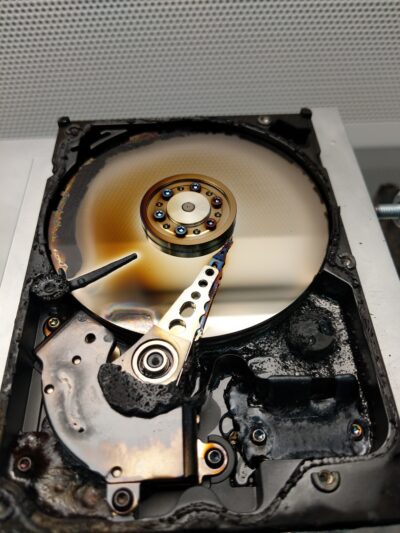When do HDDs fail
An HDD is considered “broken” or “failed” when, for example:
The PC/host machine does not recognize / ID the drive
The host PC IDs the drive, but the drive’s reaction speed is significantly lower
The host PC identifies the drive, but the drive displays access errors on every command.
Files disappear / can’t be accessed / turn into read-only
Shows normal wear and tear due to time (SMART errors etc)
The above conditions will show up on a drive for the following reasons:
Mechanical failure (e.g., damaged heads): It can be due to user mishandling (drop, impact), manufacturing faults, or natural wear of the material over time. It can also be due to incorrect power supply (destruction of head preamplifier), user intervention in the disk firmware, abrupt pulling of the power/USB cable while operating, etc.
Electronic failure (e.g., burnt PCB): This is caused by power fluctuations, faulty power supply, incorrect power input (e.g., 19V plug from a laptop to the external drive instead of 12V), short-circuit, etc.
 Surface (Media) damage of the drive’s surface (e.g., Bad Sectors): The development of Bad Sectors on the surface of a disk depends on many factors, such as poor quality of the disk surface material, wear and tear over time, impact/shock while operating, defective/degraded heads, overheating, etc.
Surface (Media) damage of the drive’s surface (e.g., Bad Sectors): The development of Bad Sectors on the surface of a disk depends on many factors, such as poor quality of the disk surface material, wear and tear over time, impact/shock while operating, defective/degraded heads, overheating, etc.Other extreme conditions like fire, flood, or even sabotage naturally have destructive consequences on the data surface and, consequently, on the drive itself. Fire causes the loss of the disk’s magnetic properties, and if the Curie point is exceeded, the disk is considered 100% unrecoverable as these properties are permanently lost. Similarly, flooding can cause irreparable damage to the disk surface if water (or mud) enters its interior, while seawater has corrosive properties due to the salts.
Handling Error: Many times, drives that are considered “faulty” arrive at our labs, as the “files have disappeared.” Excluding the possibility of a virus or Ransomware, it usually comes down to user error, where the user has deleted the files from their drive. For SSDs, this can create irreversible situations.
Manufacturing defects: There are notorious cases where certain models of drives exhibited problems without any of the above conditions being met. For example, the BUSY bug of Seagate Barracuda 7200.11 hard drives with firmware SD15 or SD81, where without any warning the drive would go into a BUSY state and would not be recognized by any PC. Similarly, some Seagate hard drives (mainly the 7200.10, 7200.11 and less so the 7200.12) went into a spindle lock state and were unable to spin their motor due to defective lubrication material.

